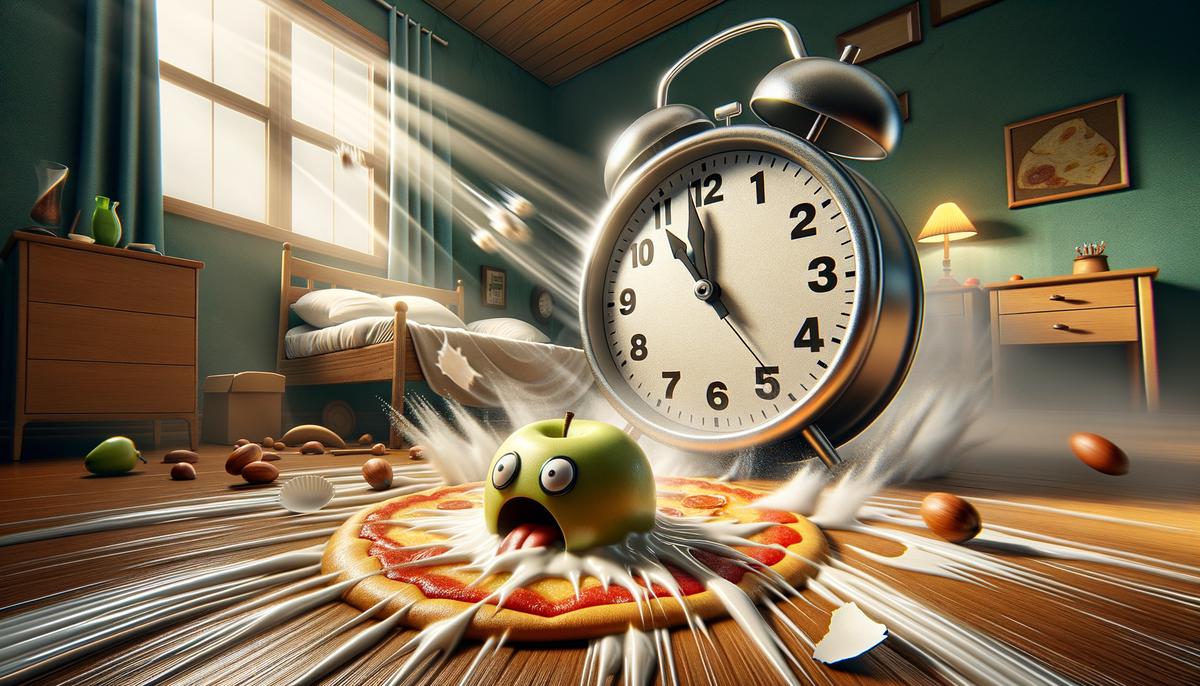The Five-Second Rule is a concept familiar to many, suggesting that food dropped on the floor might still be safe to eat if picked up quickly. This article explores the origins, scientific investigations, and cultural perceptions surrounding this rule. From its historical roots to modern scientific scrutiny and its role in society today, we aim to provide a comprehensive look at how this simple idea intersects with broader themes of food safety, hygiene practices, and human behavior.
Origins of the Five-Second Rule
The Five-Second Rule: Unveiling Its Origins
The familiar phrase “the five-second rule” is often heard in homes and restaurants alike. But where did this concept, which suggests food dropped on the floor is safe to eat if picked up within five seconds, originate? This exploration sheds light on the story behind this widely recognized rule.
Tracing back its roots, the five-second rule doesn’t owe its existence to a specific study or scientific discovery. Instead, it appears to have grown out of common folklore and society’s collective habits over generations. The earliest recorded mention connects to Genghis Khan, the 13th-century Mongol ruler, who supposedly proclaimed that food could sit on the floor for a considerably longer time than five seconds before it was deemed unfit to eat. This “Khan’s rule” emphasized the trust and value he placed on the food prepared for him, indicating a form of respect for the nourishment provided.
As time progressed, the notion budded in different cultures, yet the direct source remained blurry. The adaptation to a five-second timeframe seems to be a modern contraction of this ancient practice, nuanced by science and public health understanding evolving over centuries. However, it wasn’t until the late 20th and early 21st centuries that scientific inquiries began to scrutinize the rule from a microbial perspective. Researchers sought to understand if common bacteria and germs indeed abided by this timeframe, marking a shift from folklore to empirical investigation.
Studies have since dissected the validity of the rule, yielding mixed results. Certain experiments concluded the type of food, surface it contacts, and specific environmental conditions crucially impact how quickly bacteria transfer from surface to sustenance. These findings suggest that while the five-second rule may occasionally hold some validity under specific circumstances, it’s not a reliable universal standard for food safety.
Yet, beyond science, the five-second rule persists in popular culture and daily conversation. It embodies society’s relationship with food, hygiene, and the inevitable accidents that occur in day-to-day life. It underlines a collective rationale towards minor mishaps — offering a humorous yet questionable justification for salvaging that delectable piece of food that slips from our grasp.
In summary, the five-second rule’s journey from an emperor’s decree to modern kitchens underscores its role beyond mere food safety debates. It encapsulates generations of inherited wisdom, desired caution against wastefulness, and perhaps, our quest for leniency in the stringent standards of cleanliness. Thus stands the five-second rule, a mosaic of history, culture, and science; simple in its premise, yet complex in its origin.

Scientific Investigations into the Five-Second Rule
Delving further into scientific examinations of the five-second rule, a range of institutions has conducted studies to assess its validity under the lens of modern science. A notable investigation comes from Rutgers University, which decided to put the rule to the test across various food and floor types. This study, published in 2016, looked at how factors like moisture, surface type, and contact time affect bacteria transfer. Their findings? Bacteria can attach to food in less than a second, debunking the idea that waiting five seconds is a safe buffer.
Moreover, their research illuminated that moisture plays a pivotal role in this transfer, with wetter foods picking up bacteria more readily than dry ones. Surface type also mattered, with tile and stainless steel being more prone to transferring bacteria compared to carpet. Yet, even with these insights, the study acknowledges the complexities in fully disproving the rule, given the myriad variables involved.
Taking a step back to review earlier inquiries, a study by the University of Illinois at Urbana-Champaign in 2003 played a foundational role in sparking scientific interest in the subject. Researchers there dropped gummy bears and fudge-striped cookies on different surfaces and concluded that fewer bacteria were transferred when the contact duration was shorter. But like the Rutgers study, it hinted at the importance of surface conditions, pointing out that smoother surfaces tend to be more forgiving for quick pickups.
On another front, the Aston University study in 2014 aimed at unravelling the effect of different floors (like carpet, laminate, and tiled surfaces) on bacteria contamination. Results tended to suggest the five-second rule could indeed have merit in specific instances. However, like its predecessors, this study called attention to varying factors that influence bacterial transfer — echoing a consensus that while the rule might capture a sliver of truth under certain conditions, it isn’t a one-size-fits-all safety guideline.
Through these studies, the scientific community has begun to sketch a picture filled with nuance rather than definitive answers. Each investigation, while tackling different aspects of food, bacteria and flooring, contributes to a growing understanding that while there may be instances where food could survive a brief floor encounter with minimal contamination, variability in conditions makes it impossible to declare the five-second rule universally applicable.
Amid this investigative journey into the risks associated with the five-second rule, an underlying message from the scientific realm emphasizes caution rather than compliance with this adage. The notion that bacteria’s contamination speed can outpace a lightning-fast pickup underscores the potential risks involved — risks that change depending on the accident’s specifics.
What these investigative efforts display is a willingness to question and probe notions that have become embedded within society. They demonstrate scientific curiosity put to work, challenging societal norms with data and analysis, albeit within the boundary of acknowledging that everyday scenarios are complex, changing, and not easily captured by simple rules. In essence, while science seeks to offer guidance, it also acknowledges the multifaceted conditions that influence outcomes in our lived experiences — a dynamic reflective of both scientific inquiry and the nuanced reality of the five-second rule.

Factors Influencing Bacterial Transfer
When talking about transferring bacteria from surfaces to food, it’s clear that not all surfaces and foods are created equal. This distinction plays a vital role in understanding why and how bacteria hop from a table or floor onto that piece of pizza you accidentally dropped.
Firstly, the type of surface matters more than you might think. Smooth, hard surfaces, like a kitchen countertop or a ceramic tile floor, might allow bacteria to make the jump to food more easily compared to rougher surfaces. Counterintuitively, rougher surfaces have nooks and crannies where bacteria can hide, but those same crevices can also trap the food, making direct contact with bacteria less likely.
Conversely, the type of food plays a crucial role as well. Moist foods, like a slice of apple, are like a welcome mat for bacteria. The moisture acts as a bridge, facilitating bacteria’s transfer to the food. Dry foods, on the other hand, don’t offer the same hospitable environment for bacteria to hitch a ride.
Temperature also plays a not-so-obvious role in the transfer of bacteria from surface to food. Hot foods can sometimes kill bacteria on contact, but as the food cools down to room temperature, it becomes more inviting for bacteria. That’s why foods left out too long, even without touching a surface directly, can become bacterial hotspots.
The presence of organic material on surfaces introduces another layer of complexity. Surfaces that have remnants of food or liquids on them are breeding grounds for bacteria, increasing the likelihood of transfer onto your dropped morsel. A clean surface, in contrast, reduces the risk considerably.
Timing, though not strictly within the original five-second rule’s claim, does influence bacterial transfer. The longer food remains in contact with a contaminated surface, the greater the chance for bacteria to move over. Quick retrievals reduce this risk, but they don’t eliminate it completely.
Last but not least, human behavior influences these factors significantly. Habits like regularly cleaning surfaces and properly storing foods can reduce the risk elements involved in the bacteria’s migration journey. Understanding that dropping food doesn’t automatically doom it to contamination is important, but so is recognizing when it’s better to just let it go.
In navigating the day-to-day decisions about food safety, it becomes clear that the transfer of bacteria from surfaces to food isn’t just about time. It’s a multidimensional interplay of factors including surface material, food moisture, temperature, cleanliness, and our own behaviors. Steering through these variables can help minimize unwanted microscopic guests at our next mealtime rendezvous.

Expert Opinions on the Five-Second Rule
Addressing the assorted implications of adhering to the five-second rule, experts hint at broader topics than mere bacteria transfer. Beyond surface-level concerns, the rule invites discussions around behaviors, health education, and reasoning behind quick decisions made in mundane moments. The act of employing the rule, albeit fleetingly pondered, unfolds layers about instinctual versus informed decision-making processes in daily life.
The psychology behind the utilization of the five-second rule is telling. Experts explore why individuals gravitate towards applying this rule despite understanding its scientific ambiguity. This inclination leans heavily on the human tendency to rationalize shortcuts in decision-making, especially in low-stakes scenarios. Psychologically, it serves as a comforting mechanism to justify actions that are more about convenience than health consciousness.
In discussions about the five-second rule, health educators emphasize its role in navigating broader food safety practices. While the rule itself may not hold up under scientific scrutiny, it opens avenues for important discussions on safe food handling. Proponents advocate for using it as a teaching moment, to encourage deeper understanding and awareness regarding how food contamination really works and promoting more rigorous hygiene standards.
Moreover, the persistence of the five-second rule sparks conversations around societal evolution in hygiene practices. Historical perspectives show changing attitudes toward cleanliness and wastefulness, suggesting that modern interpretations of the rule may reflect current societal values and economic conditions. This illustrates how cultural practices can both shape and be shaped by prevailing social norms concerning health and resources.
Assessing risk plays a crucial part in deciding whether or not to invoke the five-second rule. Experts note that individual assessments of edible salvaging post-fall often omit a critical analysis of potential health risks versus the loss of food. This selects for an interesting discussion point on risk perception in everyday life decisions, hinting at broader implications about how people gauge and react to hazards.
The debate surrounding the five-second rule doesn’t find its terminus at the crossroad of science and folklore. Instead, it stretches into territories of habit formation, education on hygienic practices, societal values, and even the psychology of decision-making. In detailing these aspects, the exploration yields more than just a verdict on the rule’s accuracy but delves into how such a seemingly simple belief integrates into the complex fabric of human behavior and cultural practices.
By examining these layers, one gains insight not only into the validity of the five-second rule but also into the intricate ways in which science, culture, psychology, and education interlace within the matrix of everyday life decisions. Far from being a mere myth to debunk or validate, the rule emerges as a focal point for multidisciplinary dialogue, extending its relevance beyond the realm of microbiology into understanding human nature’s complexities.

Public Perception and Behavior
Though persistently fascinating, the five-second rule hasn’t just captivated the scientific community; its impact spans much broader, touching upon the fabric of societal behavior and cultural norms. At its core, the rule operates within a spectrum of folk wisdom and scientific skepticism, hence influencing both public perception and action in surprisingly diverse ways.
To understand this phenomenon’s societal footprint, we must delve into how individuals interpret and apply the rule in their daily lives. For many, the five-second rule is more than just an old wives’ tale; it’s a quick decision-making tool when navigating the often unpredictable terrain of food safety. This split-second calculation isn’t just about deciding if a piece of dropped food is worth saving—it encapsulates a broader dialogue about risk, cleanliness, and the value we attribute to what we eat.
The public’s engagement with the five-second rule also unveils deeper narratives about modern hygiene practices and their variance across different communities. In an age where information—and misinformation—about health and safety circulates with unprecedented speed, the rule offers a touchstone of simplicity. However, this isn’t to suggest that its application is uniform. Individual responses can vary greatly based on personal attitudes towards food safety, ingrained habits, and even socio-economic factors.
Education and awareness about hygienic practices play crucial roles too. While the five-second rule is mentioned in jest, its presence in conversations about food safety opens doors to more nuanced discussions. For instance, understanding why the Rule does not provide a universal safety net begs for deeper inquiry into what truly determines food spoilage risk—highlighting the importance of cleanliness, food handling, and storage practices.
Moreover, the persistence of the five-second rule in popular culture underscores society’s ongoing struggle to balance caution against wastefulness. This precarious balance reflects broader environmental and ethical concerns, pushing against the throwaway culture that has become all too common. In this light, the impulse to save a perfectly good piece of food from being discarded might seem trivial, but it gestures toward more significant conversations about consumption and waste.
Finally, assessing public perception of the five-second rule reveals a collective exercise in risk versus reward, a calculation influenced by factors far beyond the mere presence of bacteria. The rule, in its simple formulation, caters to a universal impulse: to salvage what we value. Yet, its execution is anything but simple, fraught with considerations about health, hygiene, and personal principles.
Navigating the web of implications surrounding the five-second rule thus offers a mirror to our societal values and concerns, making it a compelling subject of study beyond its folklore status. As we inch forward, it remains to be seen how evolving knowledge on food safety might tilt the balance of public opinion and action concerning this enduring piece of wisdom—or if, against all odds, the five-second rule will continue to find grounding in the messy realities of daily life.

Comparative Analysis of Global Food Safety Practices
While the five-second rule is a point of both humor and contemplation in many Western societies, it’s intriguing to compare this adage to food safety practices observed in other cultures around the globe. This exploration not only shines a light on how various societies approach the concept of cleanliness and food safety but also highlights the diverse attitudes towards food preservation and consumption practices worldwide.
In many Asian cultures, for example, the emphasis on food safety and cleanliness starts long before food reaches the floor. Japan is renowned for its meticulous approach to food preparation and presentation, with a strong cultural emphasis on minimizing contamination at all levels of food handling. The Japanese tradition of handling food with care and reverence essentially makes the concept of the five-second rule irrelevant. Here, the societal norms gravitate more towards preventing food from ever touching the ground in the first place, rather than salvaging it post-fall.
Turning our gaze towards India, we find a nuanced approach to food consumption that intertwines religious beliefs with practical hygiene practices. In many Indian households, eating with one’s hands after thoroughly washing them is common, melding the practical aspect of cleanliness with a deeper, spiritual connection to one’s meals. In such environments, the Western notion of picking up dropped food might seem out of place. Instead, there’s a profound respect for food as a divine gift, where wasting it is frowned upon, yet so is consuming something that might have become tarnished by falling.
Meanwhile, in Middle Eastern cultures, there is a strong focus on communal dining and sharing meals directly from a central platter. This practice fosters a deep communal bond and a shared commitment to cleanliness and food safety, as everyone is eating from the same dish. The concept of dropping food and pondering whether it’s still consumable under a five-second rule doesn’t quite fit into this communal eating pattern. The emphasis is instead on serving and consuming food in a manner that maintains its purity for everyone involved.
Contrastingly, Scandinavian countries put a significant emphasis on food safety regulations, with strict guidelines determining how food is to be handled in both commercial and domestic settings. In such contexts, the question is not whether food is safe to eat after five seconds on the floor but how to ensure that food does not end up there in the first instance. The strong societal trust in public health advisories and guidelines means that practices like the five-second rule would be seen less as a humorous guideline and more as a departure from the norm of strict food safety adherence.
The diverse ways in which cultures approach the concept of dropped food illuminate how societal norms, religious beliefs, and public health perspectives shape our attitudes towards food safety. While the five-second rule offers a playful lens through which some might assess the risk of consuming dropped food, it’s clear that global practices vary widely. From the meticulous cleanliness observed in Japan to the communal values in the Middle East, and the regulatory trust in Scandinavia, each culture brings its own perspective to the table—none of which neatly align with picking up food from the floor within an arbitrary time frame.
These cultural insights into food safety practices beyond the five-second rule underscore the complexity of our relationship with food: it’s not merely about sustenance or pleasure but interwoven with layers of tradition, communal identity, and respect for both the provisions and those we share them with.

The Role of Media in Perpetuating the Five-Second Rule
In dissecting how the media has impacted the widespread acceptance of the five-second rule, we dive into several facets that spotlight its journey from a household saying to a cultural mainstay. The media, spanning from traditional outlets like television and newspapers to digital platforms including social media and blogs, has played a pivotal role in both perpetuating and examining the five-second rule, influencing public perception significantly.
Shows aimed at children and families often incorporate the five-second rule in episodes, portraying it as a humorous element of daily life. This can ingrain the concept from a young age, subtly suggesting that it’s a commonly accepted practice, thereby normalizing it. Meanwhile, news segments and articles frequently cover the five-second rule from a curiosity angle. Whenever a new study about the rule is published, it’s nearly guaranteed to receive wide coverage, providing scientific heft to what is ultimately a folk practice. This blend of entertainment and light scientific reporting contributes to the rule’s enduring presence in public consciousness.
Moreover, the rise of content creators on platforms like YouTube, TikTok, and Instagram has further entrenched the five-second rule into modern culture. Influencers often create videos testing the rule in various contexts, sometimes in jest and other times with a more inquisitorial bent. These experiments, although not scientific, are shared and viewed by millions, perpetuating the conversation around the rule and ensuring its place in the perpetual cycle of internet topics.
Social media platforms also facilitate a rapid exchange of opinions and personal anecdotes about the five-second rule, creating a space for communal validation. When individuals see others they respect or admire adhering to or mentioning the rule, it lends an air of legitimacy to the practice, despite what science might say.
Significantly, the presentation of the five-second rule in the media often neglects the nuances of food safety, choosing instead to focus on the rule’s quirkiness or its debated validity. Rarely is it discussed in conjunction with proper food safety practices, presenting it more as an oddity rather than a significant health consideration. This selective framing helps embed the five-second rule in popular lore while detaching it from its more critical implications about hygiene and health.
In examining the role of the media in popularizing the five-second rule, it’s clear that a variety of narratives— from scientific intrigue to casual practice— intertwine to prop up its relevance. While science offers one perspective, the broader story as narrated by the media is one of cultural acceptance and curiosity, with a generous portion of entertainment value. This mix ensures that the five-second rule persists in the public mind, a testament to the power of media in shaping and reflecting societal norms and behaviors.

As we’ve explored the multifaceted aspects of the Five-Second Rule—from its anecdotal beginnings to its examination under the lens of science—it’s clear that this rule transcends mere folklore. It prompts us to consider our relationship with food, cleanliness, and risk in everyday life. While science provides insights into the factors affecting bacterial transfer on dropped food, cultural practices remind us of the diverse ways societies approach food safety. The media’s role in perpetuating this rule highlights our collective fascination with it, blending humor with genuine curiosity about health practices. Ultimately, the enduring interest in the Five-Second Rule reflects our ongoing quest for balance between caution and convenience in a complex world.
Writio: AI content writer that ranks in Google. This was written by Writio.
Leave a Reply